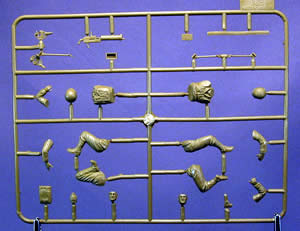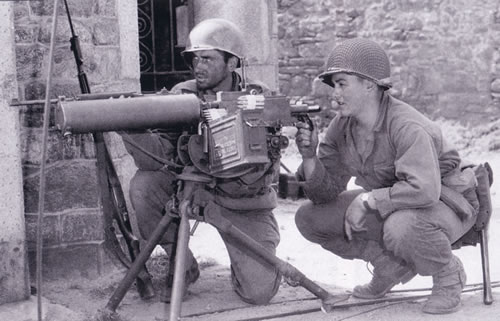|
U.S.
Machine-Gunners, Europe 1944
|
 |
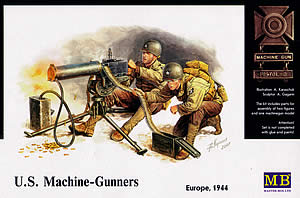
Master
Box Ltd. This pair of MG'ers is reminiscent of Tamiya's U.S. Gun and Mortar Team Set from back in the Paleozoic Age of Modeling. Except this offering from Master Box is much better, though short of excellent. As with the Tamiya kit, this box features the M1917A1 .30 Browning machine gun with the water jacket designed to cool the barrel during sustained fire; a can was used to collect steam from the heated jacket and the water could be recycled, but this is often missing from in-action photos. Another distinction from the air-cooled M1919 series, most commonly included in kits for scale modelers, is that the rear sight of the M1917 is situated atop the center of the receiver housing, while the M1919 gun's sight was located at the rear of the housing.
While this set presents only a pair of soldiers, the light machine gun squad was typically a three-man unit: gunner, loader, and ammo runner. Each rifle company had two of these squads in their heavy weapons platoon, which was attached to the company's headquarters and deployed as needed.
On the plus side, MB has produced a very nice pair of figures. They are much more refined than Tamiya's. The gunner's jacket, for example, blouses over his belt, whereas the Tamiya figure looks like he's sucking his gut in. The lacing on the canvas leggings, a commonly dodgy feature on Tamiya GIs, is much more artfully depicted by Master Box. However, the jackets on the figures, which appear to be M1941 "Parsons" jackets, have breast pockets, making the chests look more similar to the M1943 OD jacket—only with buttons down the center. The cuffs on the sleeves and tail-less bottom hem of the jacket are common to the Parsons jacket, so these don't represent any type of shirt (a shirt collar is seen under the jacket). I've inquired with Master Box to see if I've misinterpreted what I think this jacket should be, but haven't ehard back from them yet. But turning them into more accurate Parsons jackets only requires a hobby knife to scrape off the pockets.
MB has given itself an edge over other manufacturers by including insignia decals with their sets (at least for the GI figures, I can't vouch for other combatants). You get helmet markings as well as uniform patches (note the difference in sizes; helmet would be the smaller ones) for the 1st, 2nd, 29th Infantry Divisions (and perhaps 4th, if the reversed out decal is the ivy insignia), as well as the 2nd and 5th Ranger Battalions. There are even lieutenant's and captain's bars. However, there are only three corporal and sergeant stripes; with one for each arm, that's the equivalent of only one and a half soldiers. Also on the sheet are six red cross circles, which you can use on medics or medical bags. Even though the weapon is not up to the quality of the figures, there are simple workarounds on hand for most modelers that will bring this kit up to snuff. Thanks to Master Box for the sample.
-tss- |
 |
 |
 |
 |
 |
 |
 |
 |
 |
 |
 |
 |
|
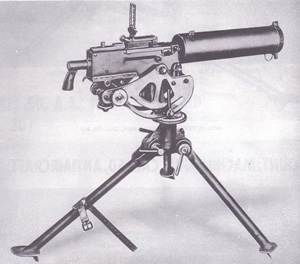 This
M1917A1 gun is supported by the tripod mount M1917A1—which
alone weighed a hefty 53 pounds! The bracket mount that cradles
the gun is the same type used on the M3 scout car, various half
tracks, and the M5/M5A1 Stuarts.
This
M1917A1 gun is supported by the tripod mount M1917A1—which
alone weighed a hefty 53 pounds! The bracket mount that cradles
the gun is the same type used on the M3 scout car, various half
tracks, and the M5/M5A1 Stuarts.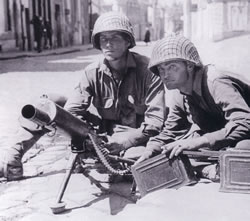 While
somewhat of an improvement over the Tamiya kit, MB's .30 is also
somewhat disappointing. To begin with, the bottom of the receiver
is oddly shaped, its top-to-bottom dimension larger at the rear
than the front, though the problem is mostly obscured by the bracket.
The grip is angled outward a bit too much, though this won't be
noticed when the figure is added. MB's bracket is superior to Tamiya's,
as is the tripod. But the latter can be enhanced with locking levers
and cleats on the bottom of the leg pads, and the gun can use a
cocking handle. The cooling jacket is a little more detailed than
Tamiya's but the tip of the muzzle that protrudes from the end is
a bit too long. The photo to the right, from Steve Zaloga's The
GI in Combat, Northwest Europe 1944-45, shows what is likely
a flash supressor (Zaloga's book has eight shots of the water-cooled
gun, surely the most I've seen in any one book). In the photo below,
from Jonathan Gawne's U.S. Army Photo Album, Shooting the War
in Color, the true size of the muzzle can be seen, as well as
the connection for the drainage hose. The box art shows the gun
equipped with the hose and collection can but they're absent from
the box.If I decide to include it, I can pull it from the spare
Tamiya kit.
While
somewhat of an improvement over the Tamiya kit, MB's .30 is also
somewhat disappointing. To begin with, the bottom of the receiver
is oddly shaped, its top-to-bottom dimension larger at the rear
than the front, though the problem is mostly obscured by the bracket.
The grip is angled outward a bit too much, though this won't be
noticed when the figure is added. MB's bracket is superior to Tamiya's,
as is the tripod. But the latter can be enhanced with locking levers
and cleats on the bottom of the leg pads, and the gun can use a
cocking handle. The cooling jacket is a little more detailed than
Tamiya's but the tip of the muzzle that protrudes from the end is
a bit too long. The photo to the right, from Steve Zaloga's The
GI in Combat, Northwest Europe 1944-45, shows what is likely
a flash supressor (Zaloga's book has eight shots of the water-cooled
gun, surely the most I've seen in any one book). In the photo below,
from Jonathan Gawne's U.S. Army Photo Album, Shooting the War
in Color, the true size of the muzzle can be seen, as well as
the connection for the drainage hose. The box art shows the gun
equipped with the hose and collection can but they're absent from
the box.If I decide to include it, I can pull it from the spare
Tamiya kit.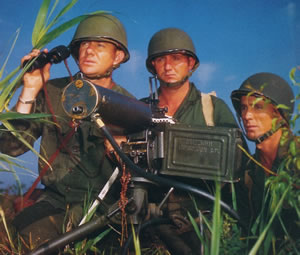 The
MB ammo box is different from the artwork, without the familiar
pressed metallic ribbing—perhaps it's a wooden box? So I may
scrounge up a spare open box (photoetched boxes have the advantage
when open at portraying the scale thickness but styrene box walls
can be suitably thinned) The ammo belt is well represented. Paint
the cloth belt white for a pre-1943 setting, or OD after that time
(though Zaloga's book shows a white belt post-D-Day).
The
MB ammo box is different from the artwork, without the familiar
pressed metallic ribbing—perhaps it's a wooden box? So I may
scrounge up a spare open box (photoetched boxes have the advantage
when open at portraying the scale thickness but styrene box walls
can be suitably thinned) The ammo belt is well represented. Paint
the cloth belt white for a pre-1943 setting, or OD after that time
(though Zaloga's book shows a white belt post-D-Day).